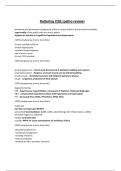Kettering CSE (patho review)
weakening and permanent enlargement of the air spaces distal to the terminal bronchioles.
hypertrophy of the goblet cells and mucus glands
dyspnea on exertion w/ significant hypoxemia and hypercapnia
COPD (emphysema chronic bronchitis)
chronic ventilatory failure
chronic hypercapnia
increased lung compliance
loss of elastic recoil
chronic CO2 retention
COPD (emphysema chronic bronchitis)
general appearance - barrel chest (increased A-P diameter) clubbing and cyanosis
respiratory pattern - dyspnea, accessory muscle use pursed lip breathing
breath sounds - diminished aeration with bilateral expiratory wheeze
Cough - congested, productive of thick sputum
COPD (emphysema chronic bronchitis)
diagnostic testing
CXR - hyperlucency, hyperinflation, increased A-P diameter, flattened diaphragm
ABG - compensated respiratory acidosis with hypoxemia and hypercapnia
PFT - decreased flows (FEV1, FEV1/FVC1, FEF25-75%)
COPD (emphysema chronic bronchitis)
treatment
low flow o2 target spo2 88-92%
aerosolized bronchodilators (SABA, LABA, anticholinergic (for inflammation), LAMA)
bronchial hygiene as indicated
inhaled corticosteroids
consider NPPV for acute exacerbations of ventilatory failure
COPD (emphysema chronic bronchitis)
education programs for -
-nutritional management
-avoiding infections
-exercise programs
-methods to aid in secretion clearance
,-home O2 and aerosol therapy
-medications and their use
COPD (emphysema chronic bronchitis)
a chronic inflammatory obstructive, non-contagious, airway disease with varying levels of severity
characterized by exacerbations of wheezing and coughing
asthma
episodes occur when patient is exposed to a specific trigger such as dust, grass, pollen, smoke, animal
dander, etc
asthma
patient assessment for -
- shortness of breath - pursed lip breathing, Chest tightness
- appearance of chest - increased A-P diameter during episode
- Respiratory pattern - accessory muscle usage, retractions (especially in children)
-Diagnostic chest percussion - hyperresonant/ tympanic
-Breath sounds - diffuse wheezing, diminished breath sounds, prolonged expiration
-physical appearance - diaphoresis
-vital signs - tachycardia, tachypnea, Pulsus paradoxus during severe episodes
asthma
diagnostic testing for -
-CXR - during acute episode increased A-P diameter, translucent (dark) lung fields, depressed or
flattened diaphragms
-ABG - initially acute alveolar hyperventilation with hypoxemia but may develop hypercarbia in status
asthmaticus
PFT - spirometry shows reduced flow rates (Peak flow, FEV1 FEV/FVC) post bronchodilator spirometry
considered significant if FEV1 increases at least 12% and 200 ml
bronchial provocation test - FEV1 decreases significantly when a provocative agent such as
methacholine is inhaled
asthma
treatment/management of acute episodes of -
-O2
- Aerosol therapy with SABA and anticholinergic agents (consider continuous aerosol therapy)
-corticosteroids
-close monitoring
-Intubation and mechanical ventilation if vent failure or respiratory arrest occurs
-consider adjunct therapies Heliox, mag sulfate, subcutaneous epinephrine
asthma
long term control of -
-triggers should be eliminated, minimized or avoided
, - control medications LABA, inhaled corticosteroids, mast cell stabilizers, leukotriene inhibitors
-action plan based on peak flow monitoring
asthma
chronic dilation and distortion of one or more bronchi as a result of excessive inflammation and
destruction of bronchial walls, blood vessels, elastic tissue, and smooth muscle
bronchiectasis
results in impaired mucociliary clearance causing accumulation of copious amounts of bronchial
secretions
bronchiectasis
one or both lungs may be affected
commonly limited to a lobe a or segment
bronchiectasis
patient assessment
history of pulmonary infections or CF
productive or purulent, foul smelling secretions, hemoptysis, sputum separate into 3 layers
bronchiectasis
general appearance - cyanosis barrel chest clubbing
respiratory pattern tachypnea dyspnea accessory muscle use pursed lip breathing
breath sounds - wheezing diminished
diagnostic chest percussion hyperresonant or tympanic
ABGs acute alveolar hyperventilation with hypoxemia (mild to mod) chronic vent failure with hypoxemia
(severe)
PFT decreased flows
bronchogram or CT scan dilated bronchi increased bronchial wall opacity
bronchiectasis
treatment for -
O2
bronchopulmonary hygiene
lung expansion therapy
antibiotics for acute infections
expectorants
aerosolized SABA and anticholinergic medications
surgical resection of involved portions as necessary
bronchiectasis
an inherited genetic disorder involving the exocrine glands. Results in thick viscous mucus
accumulation in the lungs, blocks passageways of the pancreas, and prohibits enzymes from reaching




